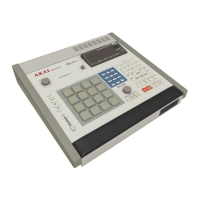Section 6: Sampling and editing sounds 135
won't load it again, but will instead use the existing
sound in memory for both drum pads.
C) Using Double play mode, assign RIDE2 to play
whenever RIDE1 is played.
D) Using the TUNING field, tune RIDE1 to "+ 0" and
tune RIDE2 to "+ 1".
E) Now, whenever you play RIDE1, RIDE1 and RIDE2
will each play the same ride cymbal sound, but at two
slightly different pitches, causing a chorus effect.
• The VOLUME field:
This is an "initial volume" for the sound, which affects all outputs. It also
serves as a convenient way to mix the assignable mix outputs, and a way to
adjust the relative volume of the 3 hihat samples. The range is 1 to 200% and
is initially set to 100%.
• The TUNING field:
This is an "initial tuning" setting for the sound. This setting is added to the
setting in the TUNE DRUMS screen and the new TUN field in the STEP
EDIT screen. For example, a TUNING setting of "+10", a TUNE
DRUMS setting of "-6", and a Step edit TUN setting of "-20" would
produce a final tuning for the note of -16 ("+10" plus "6" plus "-20" _
"-16"). This also provides a way to tune the three individual hihat sounds
(CLSD, MEDM, and OPEN).
• The START field:
This is the address within the sound at which play starts, adjustable in one
millisecond increments. Increasing this value will start the sound later into
the sample, but will not delete the unused beginning of the sound from
memory. However, the beginning may be deleted from memory by using the
<Cutoff ends> soft key, described below.
• The END field:
This is the address within the sound at which play stops, adjustable in one
millisecond increments. Decreasing this value will cause the sample to stop
playing sooner, but will not delete the unused end of the sound from
memory. However, the end may be deleted from memory by using the
<Cutoff ends> soft key, described below.
• SOFT KEY 1- <Cutoff ends>:
Normally, the START and END settings are saved with each sound
independently of the actually start and end addresses of the sample, allowing
those unused ends to be used again later. The disadvantage of this feature is
that these unused ends use extra memory. This soft key allows the unused
start and end portions of the sample to be permanently deleted, thereby
reducing the total size of the sample. To use this feature, press <Cutoff
ends> and the following screen will appear:

